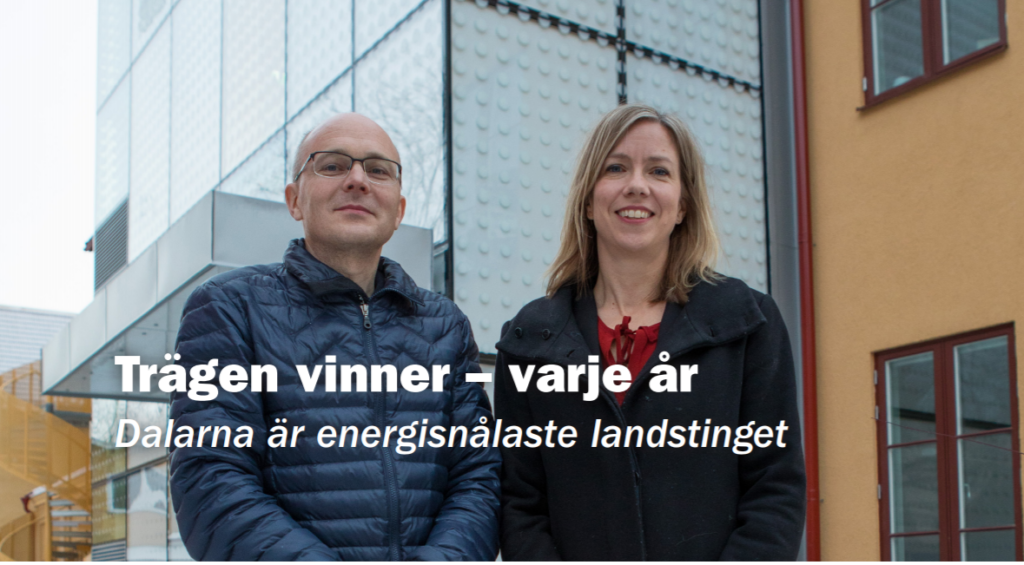No effort spared – but loads of energy. The county council of Dalarna is the best in Sweden when it comes to saving energy. In 2016 only 152 kWh per square meter was used in their buildings, this also includes electricity used for maintenance. As a comparison; in other counties the average amount used is 200 kWh.
This energy efficiency model is now a role model for others. And persistence is a key factor.
“Everybody has energy on their minds. It has been incorporated in our culture”, says Jesper Mårtensson, Energy Manager at The County Council of Dalarna.
In this sense the energy economizing culture permeates everything: newbuilds, remodeling, management, purchase and everyday life. Nobody uses the lift if it isn’t necessary, nobody carries out a refurbishment without assuring that the energy used will be cut in half. Or, at least, they try.
“Sometimes it is impossible – for example you cannot install new windows on only one level. But bearing that in mind, it can be incorporated into the building’s maintenance plan.”
Another thing that didn’t quite hit the target was the aim to use 114 kWh/square meter in the new section of Falu hospital. The figure reached was 130.
“The amount of electricity used for operation was much higher than expected due to the amount of machinery that is installed at the clinics in that house”, says Jesper.
It might seem strange to point out the failures in an article about the county with the most efficient energy use – but at the same time; this is part of The county council of Dalarna’s culture. To never be satisfied, always investigating what can be improved.
Jesper Mårtensson tells that there are real estate companies that are completely satisfied with an energy use of 200 kWh. But being down on 152, The council still feels there is lots to be done.
The target for 150 kWh/square meter in 2020 might be surpassed already in 2017. Now they go for the next goal: 90 kWm/square meter in 2050.
The national goal is somewhat more modest: 200 kWm/square meter. This was surpassed by The County Council of Dalarna already in 2004.
What’s behind the success?
“The issue is always on the agenda”, says Kristina Appelberg, Real Estate Manager. “And it has been that way for a long time, long before it became evident for others – and, of course, we are persistent”.
The first energy management plan was drafted in 1984 and it became the starting point for the systematic energy efficiency work. New plans have been introduced in 1990, 2000 and 2010 and the new one is now underway. Previous energy managers – Martin Bergdahl and Jan Sjöberg – has been responsible for putting focus on the energy issues. Now it is Kristina Appelberg’s turn to keep the flame burning.
“It becomes a positive spiral”, she says. “We get full support and lots of praise from the politicians, they are, of course, also happy for the success. And obviously for the money saved.”
This positive spiral also affects internally. Skilled staff members who are appreciated and achieves good results are more likely to stay on the job and are less absent. And it is easier to recruit new members to a workplace with satisfied staff.
“I feel that the human factor is important”, says Kristina. “We also keep the staff at a maneuverable size. This is more difficult for the larger counties.”
Both Jesper and Kristina emphasize the importance of the cooperation regarding the real estate management. The hospital and its surrounding buildings are managed by themselves but there are also private contractors that manage health centers. They have agreed on splitting the profit from energy savings in equal parts.
“When it comes to management we work very closely with annual reconciliations and setting new goals. We have also noticed; in order to get results the trustees are quite interested in investing.”
Periodic meetings each month with the management department and quarterly meeting with the private contractors, secures the progress. Red, yellow and green report figures indicate what need to be addressed. Development is constant. Jesper Mårtensson shows an illustration, a wheel to explain this: Plan, make, check, adjust. Over and over again.
“Follow up is the most important. To check what was the outcome of an effort made. If it turned out well we enforce it everywhere. If not, we adjust and enhances further.”
To know you need to measure. And so they do, down to supervision of each building, but seldom lower.
“You don’t want too much information and put yourself at risk of drowning in figures instead of saving energy”, Jesper explains.
All tenants – several hundred – are offered to sign an environmental contract (see next page) that ensures a 2 percent rent discount if the demands are met. Three quarters of the leased area is now associated to environmental contracts.
“The main gain is that these issues are put on the agenda. The downside, so far, is the administrative challenge; collecting the input and so on. But we are working on it”, says Jesper Mårtensson.
Åke Persson, Operational Manager at Byggdialog Dalarna, is deeply impressed by The county of Dalarna’s achievements. He calls it a “model for energy efficiency” with methods and approach well worth to be applied in the rest of Sweden, and also the world!
“Maybe it doesn’t sound so impressive when they describe it themselves. But they follow a system and are persistent in a way that gives results. In addition, they have several smart solutions developed during the years. All this really deserves to be conveyed in our network and in wider circles”, says Åke Persson.
Environmental contract
All The county council of Dalarna’s tenants is offered to sign an Environmental contract. If the conditions are met they get 2 percent rental discount.
The tenant’s obligations:
- Documenting their premises’ overall environmental experiences to be handed to the landlord in November each year.
- Fast information to the managing staff regarding changes of the usage of the premises.
- To take part in interviews and investigations for analysis of the interior environment including usage of heat, electricity and water, on the landlord’s request.
- Regular information to all own personnel regarding energy efficiency, environmental aspects and internal environment.
- Supervision of all premises to ensure that there is no lightning in unused areas and establish routines to secure that all lightning and equipment is off during lights-off periods.
- Activate energy saving functions on office equipment (computers, hardcopy appliances, etc).
- Sorting of waste according to existing regulations.
- To take environmental aspects into consideration in connection with choosing materials and optimal placing of equipment. To demand for energy and water consumption records when investing in new equipment.
- To use environmentally friendly cleaning products, to clean with care to prevent unnecessary wear.
The landlord’s obligations:
- To inform the tenant about the premises’ environmental aspects e. g. during tenants’ meetings.
- To keep informed about the tenant’s operation in order to suggest improvements.
- To control the tenant’s fulfilment of the contract’s intentions.
- To encourage the staff’s efforts by offering incitements for saving of resources.
In 2017, 77 percent of the total area owned by The County Council of Dalarna was regulated by environmental contracts.
Saves both energy and money
The county council of Dalarna’s average energy usage was 152 kWh/square meter in 2016. The average use in Swedish counties was 200 kWh/square meter. The difference is equal to an annual saving of €1.2 for the county of Dalarna.













